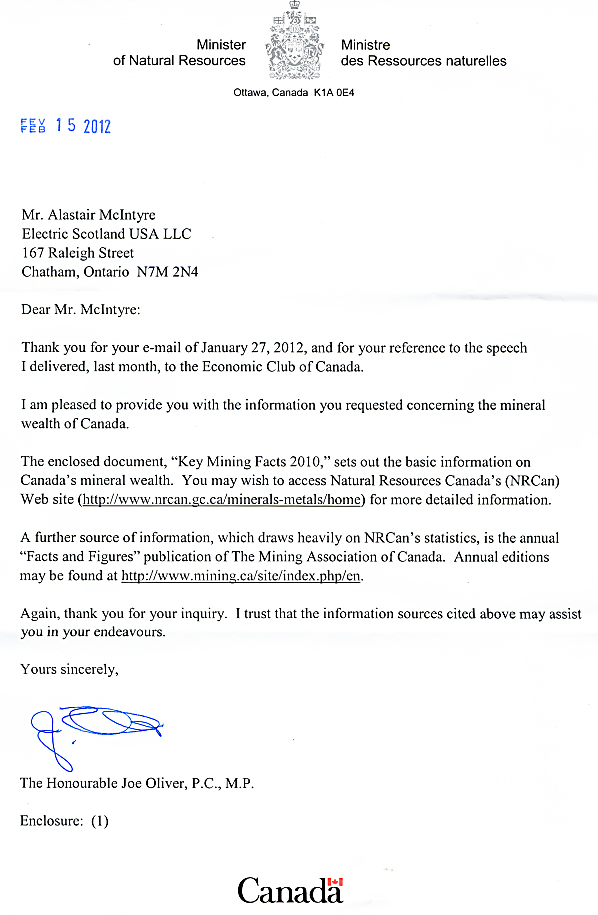|
As an introduction to Mining in Canada I
wrote to the Minister of Natural Resources as he'd given a talk covering
key facts on the industry and so hoped he might share this with us and
indeed he has as you can see from the letter below. Having read the
letter and the key fact below I then provide two links to good resources
on the mining industry and then an old book which sets the scene from an
historical perspective.

KEY MINING FACTS 2010
Canada is a global mining giant.
The value of mineral production exceeded
$41 billion in 2010 (Source: Natural Resources Canada, Annual Census of
Mines; Statistics Canada).
Canadian-headquartered mining companies accounted for more than 40
percent of budgeted worldwide exploration expenditures in 2010 (Source
Metals Economics Group, Corporate Exploration Strategies).
Canadian exploration, mining and allied industries now operate in 100
countries around the world, with cumulative assets worth $129 billion
outside Canada (2010) (Source: Natural Resources Canada, Canadian Mining
Assets).
Canada is one of the largest mining nations in the world, producing more
than 60 minerals and metals. The total value of Canadian mineral exports
was $84.5 billion in 2010. These exports accounted for 21 percent of
Canada's total exports in 2010 (Source: Natural Resources Canada, TRAGS;
Statistics Canada).
Key exports in 2010 included aluminum, nickel, copper, gold, silver,
uranium, coal, potash, zinc, diamonds, iron and steel, and iron ore.
Exports of these specific products ranged from $1.7 billion to $15
billion (Source: Natural Resources Canada, TRAGS', Statistics Canada).
In 2010, the mining and mineral processing industries made significant
contributions to the Canadian economy, including: $2.8 billion in
mineral exploration and deposit appraisal (Source: Natural Resources
Canada, Survey of Exploration, Deposit Appraisal, and Mine Complex
Development Expenditures)-, $35.1 billion in GDP (Source: Statistics
Canada, System of National Accounts); over $12 billion in capital
investment (Source: Statistics Canada, Private and Public Investment in
Canada, Catalogue 61-205); and $18 billion in trade surplus (Source:
Natural Resources Canada - TRAGS', Statistics Canada. They also
accounted for the majority of goods transported by rail and by vessel
(Source: Statistics Canada, Marine Transportation Custom Run; Statistics
Canada, Monthly Railway Carloadings, Catalogue 52-001).
In 2010, more than half (55.7 percent) of the world's equity financing
for mineral exploration and mining was raised by companies listed on
Canadian stock exchanges.
More than 308,000 Canadians are employed in the mining and mineral
processing industries, creating employment opportunities from coast to
coast to coast, and in urban and rural areas, including many Aboriginal
and northern communities (Source: Statistics Canada, Survey of
Employment Payroll and Hours).
Iron ore was the top metallic mineral produced in Canada in 2010, with
shipments valued at $5.0 billion. Gold production was next, at $3.9
billion, followed by copper at $3.8 billion (Source: Natural Resources
Canada, Annual Census of Mines) Statistics Canada).
The leading non-metallic minerals produced were potash at $5.7 billion,
diamonds at $2.4 billion and cement at $1.5 billion (Source: Natural
Resources Canada, Annual Census of Mines) Statistics Canada).
Canada continues to be the world leader in the production (by volume) of
potash (Source: United States Geological Survey).
Canada ranks in the top five countries for the production of aluminum,
cadmium, molybdenum, nickel, platinum metals, salt, sulphur, titanium
concentrates, uranium and zinc, and ranks third in the production of
diamonds (by value) (Source: United States Geological Survey).
You may wish to access
Natural Resources Canada’s (NRCan) Web site ( http://www.nrcan.gc.ca/minerals-metals/home)
for more detailed information.
A further source of
information, which draws heavily on NRCan’s statistics, is the annual
"Facts and Figures" publication of The Mining Association of Canada.
Annual editions
may be found at
http://www.mining.ca/site/index.php/en
Economic Minerals and Mining Industry of Canada
By the Staff of the Mines Branch
CONTENTS
Preface
Introductory
Mineral production of Canada in 1912
Economic minerals and associated industries
Metallic Minerals—
Aluminium
Antimony
Arsenic
Cobalt
Copper
Gold
Iron
Lead
Molybdenum
Nickel
Platinum and palladium
Silver
Tin
Tungsten
Zinc
Non-Metallic Minerals—
Asbestos
Chromite
Coal
Corundum
Feldspar
Fluorspar
Graphite
Grindstones
Gypsum
Magnesite
Manganese
Mica
Mineral pigments
Iron ochres
Barytes
Mineral water
Natural gas
Peat
Petroleum
Phosphate
Pyrites and sulphur
Salt
Talc
Tripolite
Clay
and quarry products—
Cement
Clays and clay products
Stone quarries and lime
Slate
The Real Cobalt
The Story of Canada's Marvellous Silver Mining Camp by Anson A Gard
Hunter Dickinson Inc.
(HDI)
A Diversified Global Mining Company
Videos
Here we provide a few videos about mining in Canada
The Canadian Mining &
Mechanical Review
The Official Organ of the Gold Miners Association of Nova Scotia and the
Representative Exponent of the Canadian Mining & Mechanical Industry
Mineral
Resources of Canada
To Celebrate The Visit of the British and Continental Mining Engineers
and Metallurgists to Canada in the Summer of 1908 published by the
Canadian Mining Journal (1908) (pdf)
Annual Report of the Mineral
Production of Canada
During the Calendar Year 1923 (pdf)
Mining camps of British Columbia (pdf)
The Canadian Critical
Minerals Strategy
From Exploration to Recycling: Powering the Green and Digital Economy
for Canada and the World (2023) (pdf) |
